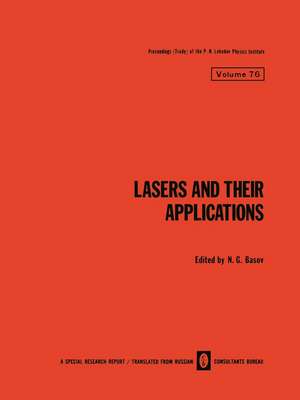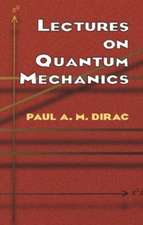Lasers and Their Applications / Lazery I Ikh Primenenie / Лазеры И Их Применение: The Lebedev Physics Institute Series, cartea 76
Editat de N. G. Basoven Limba Engleză Paperback – 26 iun 2012
Din seria The Lebedev Physics Institute Series
-
 Preț: 394.12 lei
Preț: 394.12 lei -
 Preț: 400.65 lei
Preț: 400.65 lei -
 Preț: 389.70 lei
Preț: 389.70 lei -
 Preț: 393.35 lei
Preț: 393.35 lei -
 Preț: 389.70 lei
Preț: 389.70 lei -
 Preț: 382.57 lei
Preț: 382.57 lei -
 Preț: 380.84 lei
Preț: 380.84 lei -
 Preț: 386.39 lei
Preț: 386.39 lei -
 Preț: 371.26 lei
Preț: 371.26 lei -
 Preț: 390.84 lei
Preț: 390.84 lei -
 Preț: 388.13 lei
Preț: 388.13 lei -
 Preț: 391.79 lei
Preț: 391.79 lei -
 Preț: 391.22 lei
Preț: 391.22 lei -
 Preț: 384.48 lei
Preț: 384.48 lei -
 Preț: 387.75 lei
Preț: 387.75 lei -
 Preț: 380.84 lei
Preț: 380.84 lei -
 Preț: 386.81 lei
Preț: 386.81 lei -
 Preț: 389.70 lei
Preț: 389.70 lei -
 Preț: 384.48 lei
Preț: 384.48 lei -
 Preț: 384.70 lei
Preț: 384.70 lei -
 Preț: 382.57 lei
Preț: 382.57 lei -
 Preț: 397.38 lei
Preț: 397.38 lei -
 Preț: 389.70 lei
Preț: 389.70 lei -
 Preț: 381.59 lei
Preț: 381.59 lei -
 Preț: 394.12 lei
Preț: 394.12 lei -
 Preț: 384.09 lei
Preț: 384.09 lei -
 Preț: 393.35 lei
Preț: 393.35 lei -
 Preț: 389.31 lei
Preț: 389.31 lei -
 Preț: 388.13 lei
Preț: 388.13 lei -
 Preț: 384.86 lei
Preț: 384.86 lei -
 Preț: 386.22 lei
Preț: 386.22 lei -
 Preț: 393.74 lei
Preț: 393.74 lei -
 Preț: 389.31 lei
Preț: 389.31 lei -
 Preț: 398.35 lei
Preț: 398.35 lei -
 Preț: 387.38 lei
Preț: 387.38 lei -
 Preț: 388.13 lei
Preț: 388.13 lei -
 Preț: 395.85 lei
Preț: 395.85 lei -
 Preț: 387.38 lei
Preț: 387.38 lei -
 Preț: 389.31 lei
Preț: 389.31 lei -
 Preț: 382.95 lei
Preț: 382.95 lei -
 Preț: 388.72 lei
Preț: 388.72 lei -
 Preț: 390.08 lei
Preț: 390.08 lei -
 Preț: 393.35 lei
Preț: 393.35 lei -
 Preț: 394.87 lei
Preț: 394.87 lei -
 Preț: 386.81 lei
Preț: 386.81 lei -
 Preț: 381.98 lei
Preț: 381.98 lei -
 Preț: 385.25 lei
Preț: 385.25 lei -
 Preț: 298.07 lei
Preț: 298.07 lei
Preț: 393.13 lei
Nou
Puncte Express: 590
Preț estimativ în valută:
75.23€ • 78.74$ • 62.61£
75.23€ • 78.74$ • 62.61£
Carte tipărită la comandă
Livrare economică 31 martie-14 aprilie
Preluare comenzi: 021 569.72.76
Specificații
ISBN-13: 9781468416220
ISBN-10: 1468416227
Pagini: 223
Ilustrații: VII, 223 p.
Dimensiuni: 210 x 279 x 12 mm
Greutate: 0.54 kg
Ediția:1976
Editura: Springer Us
Colecția Springer
Seria The Lebedev Physics Institute Series
Locul publicării:New York, NY, United States
ISBN-10: 1468416227
Pagini: 223
Ilustrații: VII, 223 p.
Dimensiuni: 210 x 279 x 12 mm
Greutate: 0.54 kg
Ediția:1976
Editura: Springer Us
Colecția Springer
Seria The Lebedev Physics Institute Series
Locul publicării:New York, NY, United States
Public țintă
ResearchCuprins
Experimental and Theoretical Investigations of the Dynamics of High—Power Radiation—Emitting Electric Discharges in Gases.- §1. Methods for Initiating Discharges with Large Radiating Surfaces.- §2. Optical, Gasdynamic, and Energy Characteristics of High-Power Electric Discharges.- §3. Self-similar Theory of a Discharge in an Unbounded Medium.- §4. Allowance for the Discharge Circuit Equation in Self-similar Description of a Discharge. Comparison with the Experimental Results.- §5. Numerical Calculations of Characteristics of High-Current Discharges in Air 2.- §6. Stability of High-Current Discharges in Gases.- Literature Cited.- Radiation, Dynamics, and Stability of a High-Current Lithium Discharge Plasma.- I. Theoretical Investigations of High-Current Discharges in Bounded Plasmas.- §1. Steady-State Conditions.- §2. Discharge Stability.- §3. Numerical Calculations of Discharge Dynamics in a Lithium Plasma.- II. Experimental Investigations of Discharges in Lithium Plasmas..- §1. Energy Balance in Discharges.- §2. Dynamics and Stability of Discharges.- §3. Measurements of Radiation Fluxes and Spectra.- §4. Investigations of Large-Scale Structure of Discharges.- §5. Investigations of Small-Scale Structure of Discharges.- §6. Discussion of Results and Comparison with Theory.- Literature Cited.- Generation and Amplification of Light by Stimulated Scattering.- I. Dynamics of Raman Lasers.- §1. Theoretical Analysis of the Dynamics of Emission from a Raman Laser.- §2. Experimental Investigations of Raman Laser Dynamics.- §3. Conditions for Attaining Maximum Quantum Efficiency and Minimum Divergence of Raman Laser Output.- II. Fundamentals of the Theory of Amplifiers Based on Stimulated Scattering.- §1. Equations Describing Amplification.- §2..ParallelAmplification.- §3. Opposed Amplification..- ?. Experimental Investigation of Amplification due to Stimulated Raman Scattering.- §1. Dynamics of Amplification and Saturation Effect.- §2. Influence of Pump Radiation Spectrum on Amplification due to Stimulated Scattering.- §3. Competition between Different Types of Stimulated Scattering.- §4. Formation of Light Pulses with the Aid of Stimulated Scattering.- Literature Cited.- Theoretical Investigation of the Kinetics of Chemical Lasers.- §1. Characteristics of the Kinetics of Pulse Chemical Lasers.- §2. Kinetic Models of H2 + F2 and D2 + F2 + CO2 Systems and Calculation Methods.- §3. H2 + F2 System.- §4. D2 + F2 + CO2 System.- Conclusions.- Literature Cited.- Plasma Heating and Neutron Generation Resulting from Spherical Irradiation of a Target with High-Power Laser Radiation.- I. Desired Parameters of Laser Systems.- §1. Radiation Contrast.- §2. Divergence of Radiation.- §3. Efficiency of Laser Systems.- II. Master Laser and System of Preliminary Amplifying Stages.- §1. General Description of Apparatus.- §2. Master Laser.- §3. Investigation of Spatial-Temporal Coherence of Laser Radiation.- §4, Width of Emission Line.- §5. Amplifying Properties of Preliminary Stages and Parameters of Radiation Leaving These Stages.- III. High-Power Amplifying Stage with Series-Parallel Configuration.- §1. Amplifying Stage Configuration.- §2. System for Dividing High-Power Beams.- §3. Contrast of Radiation Emerging from High-Power Amplifier.- §4. Parameters of Radiation at the Exit from High-Power Amplifier.- §5. System for Focusing Radiation on a Target.- IV. Investigation of the Parameters of a Plasma Formed as a Result of Spherical Irradiation of an Isolated Solid Target.- §1. Vacuum Chamber. DiagnosticApparatus •.- §2. Investigation of the Efficiency of Energy Supply to a Heated Target.- §3. Investigation of X-Ray Emission..- §4. Investigation of the Neutron Yield of Plasma.- §5. Reflection of Laser Radiation from Dense Plasma.- §6. Gasdynamic Pressure of “Corona” and Cumulative Compression of Plasma Core.- Literature Cited.- Investigation of the Parameters and Dynamics of a Plasma Obtained by Sharp Focusing of Laser Radiation on Solid Targets.- §1. Introduction.- §2. Characteristic Parameters of Laser Jets.- §3. Temperature Measurements..- §4. Gasdynamic Motion of Laser Plasmas....- §5. Distribution of Electron Density in Laser Plasmas.- §6. Ionization State of Multiply Charged Laser Plasmas.- §7. Laser Plasma as a Source of Multiply Charged Ions...- Conclusions..- Literature Cited.















